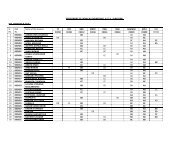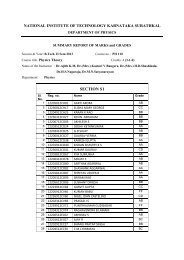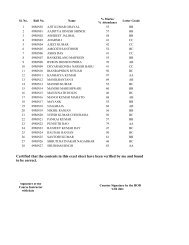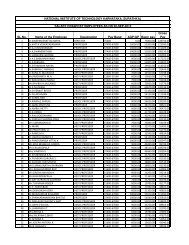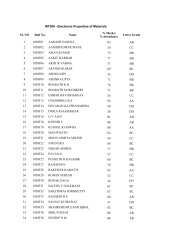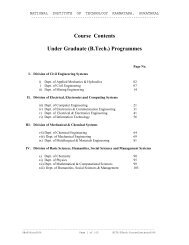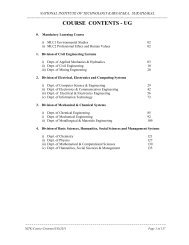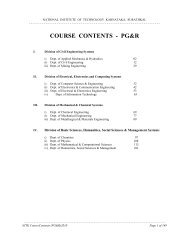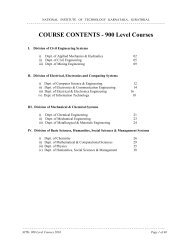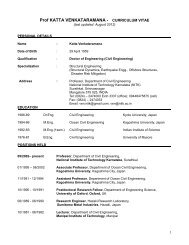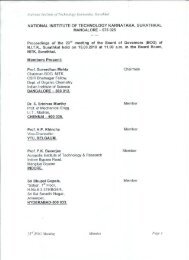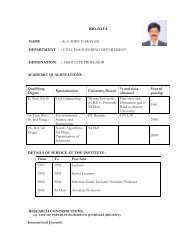course contents - ug - National Institute of Technology Karnataka
course contents - ug - National Institute of Technology Karnataka
course contents - ug - National Institute of Technology Karnataka
Create successful ePaper yourself
Turn your PDF publications into a flip-book with our unique Google optimized e-Paper software.
NATIONAL INSTITUTE OF TECHNOLOGY KARNATAKA, SURATHAKAL<br />
------------------------------------------------------------------------------------------------------------------<br />
CY351 PHYSICAL CHEMISTRY OF POLYMERS (3-0- 0) 3<br />
Kinetics <strong>of</strong> free radical, ionic, coordination and step polymerization, copolymerization. Phase transitions:<br />
Kinetics and mechanism <strong>of</strong> polymer crystallization.Amorphous polymers. Thermodynamics and theory <strong>of</strong><br />
polymer solutions, Flory H<strong>ug</strong>gins theory, UCST and LCST. Determination <strong>of</strong> molecular weights <strong>of</strong><br />
polymers �osmometry, viscometry, light scattering methods. Rheological properties <strong>of</strong> solutions and<br />
polymer melt. Liquid crystalline state. Electrical properties <strong>of</strong> polymers. Elastomers � theory <strong>of</strong> elasticity.<br />
A. Tager, Physical Chemistry <strong>of</strong> Polymers, MIR Publishers, 1972.<br />
Anil Kumar and Santhosh K Gupta, Fundamental <strong>of</strong> Polymer Science and Engineering, Tata Mcgraw-<br />
Hill Publishing Co. Ltd. India, New Delhi, 1970.<br />
CY352 PHARMACEUTICAL CHEMISTRY (3–0–0) 3<br />
Introduction, classification and nomenclature <strong>of</strong> dr<strong>ug</strong>s. Theories <strong>of</strong> dr<strong>ug</strong> action and factors affecting.<br />
Assay <strong>of</strong> dr<strong>ug</strong>s and their metabolism. Sedatives. Analgesics. Antihistamins. Antiinflammetory,<br />
Antimalarial. Antifungal, Antiviral agents. Steroids. Sulphonamides and Antibiotics. Organic<br />
pharmaceutical aids. Chemical models and mimics for enzymes, receptors, carbohydrate and other<br />
bioactive molecules, catalytic antibodies. Molecular modeling, conformational analysis, qualitative and<br />
quantitative structure and activity relationships.<br />
Ed. Manfred E. Wulf, Burger’s Medicinal Chemistry and Dr<strong>ug</strong> Discovery, Vol. 1-6, John Wiley,<br />
New York, 1995.<br />
G. R. Chatwal, Pharmaceutical Chemistry, Vol. I and II, Himalaya Publishing House, Delhi, 2 nd edition,<br />
1997.<br />
CY353 FOOD CHEMISTRY (3–0–0) 3<br />
Components <strong>of</strong> food: Carbohydrates, Fats and oils, Proteins, Vitamins, Minerals. Food Microbiology:<br />
Interaction between microorganism and food, mechanism <strong>of</strong> spoilage, food borne illness and<br />
fermentation. Cryogenic food preservation. Water activity and storage stability. Drying techniques. Food<br />
and food by-products processing industries. Food preservatives, Fragrances. Flavours. Food additives.<br />
Interesterification <strong>of</strong> oils. Food packing, materials, and methods. Analysis <strong>of</strong> food proteins, fats,<br />
carbohydrates, vitamins, etc.<br />
T. P. Coultate, Food – The Chemistry <strong>of</strong> Components, RSC, 2002; C. W. Hall, Encyclopedia <strong>of</strong> Food<br />
Engineering, AVI publishing, 1971. M. Karel and D. B. Lund, Principles <strong>of</strong> Food Science, M. Decker,<br />
New York, 1975.<br />
CY355 TECHNICAL ANALYSIS LAB. (0–0–3) 2<br />
Experiments involving electrochemistry, kinetics, chromatography, spectroscopy, thermo-chemistry �<br />
Potentiometry, Conductometry, Refractometry, Polarimetry, Viscometry, Polarography and<br />
Chromatography<br />
D.P.Shoemaker & C. W .Garland, Experiments in Physical Chemistry, McGrawHill 1962<br />
F. Daniels, J. W. Williams, P. Bender, R. A. Alberty and C. D. Cornwell, Experimental Physical<br />
Chemistry, McGraw-Hill, New York, 1962.<br />
CY356 CERAMIC AND POLYMER LAB. (0–0–3) 2<br />
Experiments involving evaluation <strong>of</strong> thermal, electrical, mechanical, optical, and miscellaneous properties<br />
<strong>of</strong> polymeric materials and ceramics. Chemical analysis <strong>of</strong> polymers and ceramics. Molecular weights,<br />
MFI, Strength, hardness, Specific gravity, Particle size distribution, Tg and S<strong>of</strong>tening point, Refractive<br />
index, Haze, Water permeability, Spalling resistance, Refractoriness, Chemical characterization,<br />
Identification <strong>of</strong> plastics.<br />
Cyus Klings, Physics & Chemistry <strong>of</strong> Ceramics & Refractories, Ed. Breach Science,1963<br />
Vishu Shah, Hand Book <strong>of</strong> Plastic Testing <strong>Technology</strong>, Wiley-Interscience Publication, New York, 1984.<br />
---------------------------------------------------------------------<br />
NITK-Course Contents(UG)2010 Page 121 <strong>of</strong> 134



